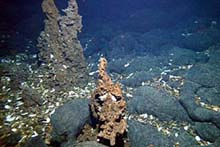
Among the discoveries made on this expedition were two sulfide chimneys about 2 m and 1 m high. They have both been built on pillow lavas and are surrounded by dead mussel shells. Photo: WHOI
Galapagos Rift Mission Summary
May 24 - June 4, 2002
The ocean exploration cruise to the Galapagos Rift, from May 24 to June 4, resulted in major discoveries at the site of the famous Rose Garden hydrothermal vent. The Rose Garden vent site is one of the sites along the Rift where, 25 years ago, hydrothermal vents were discovered for the first time and where their associated heretofore unknown chemosynthesis-based animals were first seen. These Galapagos dives were arguably the most scientifically important dives the submersible Alvin has ever made. Results of these discoveries sparked a major revolution in geological, physical, and chemical oceanography - a revolution which continues to the present. One objective of the cruise was to compare the present state of site to its state in 1977.
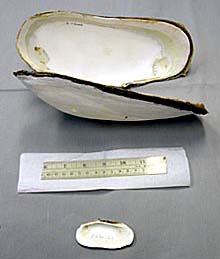
A size comparison of the young, small clams found at the Rosebud site, and the large, adult clams found at the newly discovered vent site 200 miles west of Rosebud along the Galapagos Rift. Photo: WHOI
An interdisciplinary team of ocean scientists from NOAA, several universities, and a not-for-profit company was assembled with the support of the new NOAA Ocean Exploration program. A team of 25 scientists and technicians sailed aboard the R/V Atlantis with a full complement of scientific gear, including Alvin, an autonomous undersea mapping and sensing vehicle (ABE), a deep-tow camera, a fully instrumented CTD rosette, and a high-resolution, hull-mounted sonar aboard the R/V Atlantis. In addition, the participating scientists installed on board chemical, fluid analysis, and biological laboratories in order to be able to analyze acquired data on a daily basis.
Observations during the cruise strongly support the possibility that the Rose Garden no longer exists. The vent field has apparently been covered by a lava flow that overran the site, probably within the past ten years. Although several dives were dedicated to finding the Rose Garden site, there appears to be no remaining trace of it. All of the Rose Garden vent fauna have apparently been obliterated. Moreover, there is no evidence of the many Alvin dive weights that have been dropped in the vicinity of the Rose Garden vent over the past quarter century.
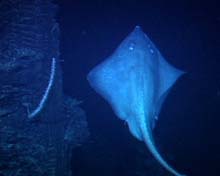
This ray is an active predator of the deep sea. There is also a deep sea coral, a sea whip, of the Order Gorgonacea. Click image for larger view.
As the team searched the region in the vicinity of the Rose Garden coordinates, however, they discovered a new community of hydrothermal animals that seem likely to be the new progenitors of a reborn Rose Garden. Aptly, the new site has been named Rosebud. Based on submersible observations and samples, Rosebud appears to be a relatively young site. At present, Rosebud is home to a wide variety of invertebrate vent-specific organisms including the famous Riftia tubeworms and large mussels and clams. The highest observed temperature of the vent fluids emanating from orifices located mainly along boundaries between adjacent basalt pillows is less than 10 degrees C.
The Rosebud discovery dramatically underscores the dynamic nature of deep sea floor processes, especially in volcanically active areas. A quantitative assessment of the variability of hydrothermal venting, and the growth and demise of their associated animal communities eventually will enable oceanographers to understand and predict the physical, chemical, and biological impacts of hydrothermal venting on the global ocean.
Four Alvin dives and several nighttime surveys were conducted to assess the physical, biological, and chemical characteristics of the Rosebud region. When these dives and surveys were completed, the team focused its efforts on an unexplored portion of the Galapagos Rift approximately 160 nm west of the Rosebud site. This part of the rift is particularly intriguing because it is among the shallowest areas along the ridge. Experience gained over the past 15 years has confirmed that such regions have a relatively high probability of hosting active vents. This hypothesis was confirmed when the team discovered a major active vent field
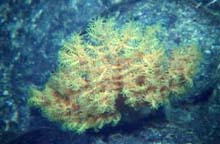
These are actually black corals, of the Order Antipatharia. The bright colors of yellow and red are contained in the coral polyps, and the stalk is black underneath. Click image for larger view.
characterized by thousands of large clams and mussels. A host of smaller invertebrates are also associated with the large mussels and clams. Interestingly, the spectacular large tubeworm, Riftia, is not present at this western Rift site, and we are unsure why. Answers to this and other intriguing questions raised by the discovery of this and the Rosebud sites, will have to wait until we can conduct shore-based analyses.
The geology of both sites was varied and dramatic. Examples of lava flow morphologies included hackly, lobate, pillow, and sheet flows. Traversing to the west site also revealed the presence of what appears to be hundreds of lava pillars. We estimate their maximum heights to be in the several tens of meters. They are the remnants of former high stands of molten lava.
Discoveries like these dramatically illustrate the growing awareness that submarine volcanic and hydrothermal activity are important in terms of the chemical, physical, and biological state of the ocean. Before the discovery of such activity, conventional wisdom held that the deep ocean was an environment that changed only at extremely slow rates and that such processes had no significant impact on any aspect of the ocean's environments. Research sparked by the Galapagos discoveries 25 years ago completely changed this view. The consequences of this discovery continue to reverberate throughout the national and international ocean research communities.
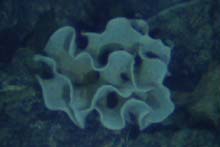
This interesting entity is actually a one celled organism called a protozoan. The size of this one is misleading for a one-celled entity; it could fit in the palm of your hand. Click image for larger view.
For example, we are now beginning to understand that deep volcanic and hydrothermal activity does impact ocean nutrient budgets and cycles, as well as influence how the deep ocean circulates.
The study of hydrothermal vents and animals continues to yield major new discoveries. One example is the discovery of a subsea floor microbial habitat where large quantities of microorganisms live in extreme conditions of heat and chemistry. These microorganisms could potentially be used in biotechnical and pharmaceutical applications.
Sign up for the Ocean Explorer E-mail Update List.















